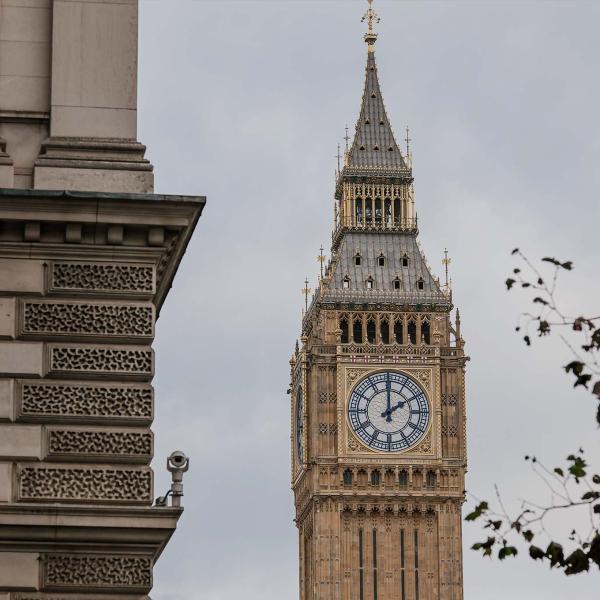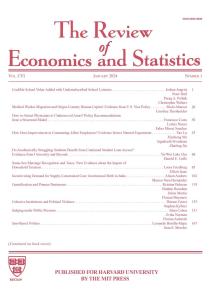Delivering on promises to increase spending on the NHS, defence and aid, and just avoiding cuts to other public service spending – a perhaps minimal definition of the “end to austerity” as promised by the Prime Minister- would require an additional £19 billion a year (in today’s prices) by 2022–23 relative to current plans. And this would still leave social security cuts worth £7 billion working their way through the system. Unless there are substantial tax rises, or much better-than-expected economic growth, the Prime Minister’s aim of “ending austerity” is unlikely to be compatible with the Chancellor’s aim of balancing the books by the mid-2020s. This leaves some tough choices for the Chancellor in the forthcoming Budget.
These are some of the main findings of the IFS Green Budget 2018, which is published today and has been produced in association with Citi and ICAEW and with funding by the Nuffield Foundation.
Absent substantial tax rises or much better-than-expected growth, “ending austerity” is not compatible with reducing the deficit further
Having fallen dramatically since its peak in 2009–10, this year borrowing will be at its lowest share of national income since 2001–02. Given that the government is committed to eliminating the deficit entirely, though, the fact that it still stood at £40 billion last year poses an ongoing problem. The Government has already committed to increase spending on the NHS, defence and aid. Just keeping spending on other public services constant in real terms would require an additional £19 billion a year (in today’s prices) by 2022–23 relative to current plans. This would be a minimal definition of the “end of austerity” promised by the Prime Minister. It would still leave social security cuts worth £7 billion working their way through the system.
Good news for the Chancellor is that borrowing this year might be around £5 billion lower than the OBR’s spring forecast of £37 billion; by 2022–23 it might be around £6 billion lower than the forecast of £21 billion. However, this would be a modest revision relative to the amount of uncertainty surrounding the public finances. Any improvement he may be able to announce will not be enough in itself to fund “an end to austerity”.
While headline borrowing is now back to pre-crisis levels, public sector net debt, at around £1.8 trillion, is higher than it was by 50% of national income having risen more quickly over the last decade than over any other decade since the Second World War. Maintaining borrowing at its current level in ‘good times’ could leave debt rising as a share of national income over the longer term. In times past a deficit at 2% of national income would have seen debt falling quite rapidly as a share of GDP. But low growth forecasts, and student loan accounting which flatters the headline borrowing measure, mean that is not true today. This does not mean that borrowing reductions need to be made immediately, but it does support further consolidation at some point.
The Chancellor faces tough decisions in next year’s Spending Review:
• Even before the next Spending Review period (which will run from 2020–21), there are planned cuts of £4 billion to the day-to-day spending of unprotected departments next year i.e. outside of health, overseas aid and Defence.
• The Government has already committed to increasing day-to-day spending on the NHS, defence and aid by £13 billion between 2019–20 and 2022–23, which includes three years of the five-year NHS funding settlement.
• But the March Spring Statement forecasts implied that day-to-day spending by central government departments overall would be cut by £2 billion between 2019–20 and 2022–23. Keeping to these plans, while meeting the commitments to increase spending, would therefore require day-to-day spending in unprotected areas to be cut by almost £15 billion over those three years.
• So, the Chancellor would need to spend £19 billion more in 2022–23 than currently planned in order to meet commitments and avoid further cuts elsewhere.
• Even ignoring the likely hit to tax revenues from leaving the EU, there is likely to be virtually no “Brexit dividend” by 2022–23. Net savings on contributions to the EU could be less than £1 billion a year by then, and the need for new spending on administration – for example, on border security – could easily exceed this modest saving.
For many decades much of the pressure on key areas of public spending has been absorbed by cutting spending on defence and security. These accounted for 15% of public spending 50 years ago, but now account for just over 5%. ICAEW shows that further cuts to the defence budget are no longer possible if the UK is to meet its NATO commitments. They suggest that defence funds could be managed better: for example, denominating a proportion of the budget in dollars would reduce the risk of having to make cuts if sterling weakens, or the incentive to spend currency gains if the exchange rate improves.
The Treasury’s Balance Sheet Review is due to report on its progress alongside the Autumn Budget. ICAEW argues that the review is an opportunity to improve the management of the government’s assets. Past mistakes – such as selling student loans at a loss – should not be repeated. The Labour party proposals for nationalisation would add to public sector assets, but the borrowing required would add considerably to liabilities. Higher revenues would follow, but there is a risk of underinvestment in the future.
One way to increase spending while still bringing the deficit down is to raise taxes.
• Raising tax revenue by 1% of national income (enough to cover £19 billion in new spending) would put the tax burden in the UK at around the highest level seen in the post-war era. One way to do this would be to add one percentage point to all income tax rates, all national insurance contribution rates, and the main rate of VAT. Such an increase would still leave the UK’s tax burden ranked near the middle of OECD countries.
• There are several options for increasing taxes in ways which would particularly affect relatively well-off members of the older generation, and which would in general improve the efficiency of the tax system. For example:
o Capital Gains Tax should not be forgiven at death, and entrepreneurs relief should be made much less generous;
o Employee NICs could be charged on earnings of those over state pension age and there is a case for levying a low rate of NICs on private pensions in payment;
o The absurdly generous treatment of accumulated pension pots which are bequeathed needs to be changed;
o There is a case for reforming council tax such that it is charged at a rate proportional to house value rather than being charged at lower rates on more expensive properties as at present.
• It might be riskier to try to raise substantial sums from those with high current earnings. We are already highly dependent on a very small group of taxpayers (a quarter of income tax revenue comes from just 0.6% of adults). Even Labour’s proposals to increase income tax rates on all those with incomes over £80,000 would perhaps raise only about £2.5 billion (although there is much uncertainty around that) – less than half what you’d get from a 1p increase in main rates of income tax, or NICs or VAT.
• Corporation tax increases could bring in substantial revenue, but are not a free lunch. Cancelling the planned cut from 19% to 17% due in 2019–20 would raise around £5 billion in the short run, though less in the longer term. Like all taxes, corporation tax is borne ultimately by households, through lower wages for workers, higher prices for consumers, or lower returns for shareholders.
Citi Research forecast more weakness in UK GDP growth for the rest of this year and early 2019 as Brexit uncertainty weighs on business investment
Increasing overall government spending without raising taxes or borrowing more requires faster economic growth. Citi Research, with whom we are collaborating for the first time this year, set out the uncertainties over the direction of the UK economy, which will be crucial for the future of the public finances.
They argue that weakness in UK growth since June 2016 has been broadly in line with forecasts made immediately after the EU referendum. The economy is around 2% smaller today than expected before the 2016 referendum in case of a pro-remain vote. They forecast more weakness in UK GDP growth for the rest of the year and early 2019; however, provided the UK and EU27 agree on a transition deal, a relief growth rally in 2019 is possible, with companies and households carrying out pent-up investment and spending plans. If the transition period lasts longer than the 21 months currently envisaged, growth could rise from 1.3% in 2018 to 1.5% in 2019 and reach 2% in 2020 based on stronger productivity growth and resilient consumer spending. But investment is likely to remain subdued until Brexit uncertainty is resolved.
The UK has successfully navigated globalisation over the last 25 years, leading the world as an advanced economy service provider and specialised manufacturer. It has depended on free trade in goods and services, as well as the inflow of capital and workers. The UK’s business model is challenged, not only by Brexit, but also by the US-led re-ordering of international trade relations, a political backlash against immigration in many advanced economies and signs that the globalisation of supply chains has peaked. Britain could face major uncertainty about its economy’s role in the world for years.
Paul Johnson, Director of the Institute for Fiscal Studies and an editor of the Green Budget, said: “The decision over the spending review envelope will probably be the biggest non Brexit related decision this Chancellor will make. He has a big choice. He could end austerity, as the prime minister has suggested. But even on a limited definition of what that might mean would imply spending £19 billion a year more than currently planned by the end of the parliament. An increase of that size is highly unlikely to be compatible with his desire to get the deficit down towards zero. Alternatively, the Chancellor could stick to his guns on the deficit and leave many public services to struggle under the strain of a decade and more of cuts. He could reconcile these demands by raising taxes, and in principle there are plenty of good options, but the overall tax burden is already high by UK historical standards and he could be constrained by the lack of a parliamentary majority. This is going to be the toughest of circles to square.”
Christian Schulz, Chief UK Economist at Citigroup and author of two chapters in the Green Budget, said: “The slowdown we and other forecasters expected after the 2016 EU referendum did happen, but with a delay. Consumption growth slowed under the pressure of high inflation, while 2018 business investment looks set to be 15% lower than forecast before the referendum. As the Article 50 deadline in March next year approaches, more households and business may delay projects, slowing growth even further. However, provided the UK and the EU avoid ‘no deal’ a growth rebound in 2019 is likely, and if the transition lasts long enough, even 2% growth by 2020 seems possible.
But the UK’s successful business model as advanced economy service provider and specialised manufacturer is not just challenged by Brexit. Globalisation may have peaked as cost differentials between China and the west are narrowing. US-led trade wars, the backlash against immigration, and financial regulation of cross-border capital flows are also a challenge to further global economic integration. Even without Brexit, the UK would be facing sustained uncertainty about its place in the global value chain for many years.”
Ross Campbell, ICAEW Director of Public Sector and co-author of two chapters in the Green Budget, said: “The long decline in defence spending may be over. Over the last fifty years, the UK has substantially reduced its spending on defence as the perceived threats to its security and interests have fallen. This has enabled public funds to be put to other uses, in particular on expanding health and welfare provision. That trend was always going to come to an end at some point; we may have reached that stage now.
Defence is one of many areas with competing demands for greater public funding by the Treasury. There are clear pressures for greater defence spending. And our meeting our NATO treaty obligations would not be consistent with further cuts to the defence and security budget. Hard choices will need to be made.”
Three chapters of the Green Budget were pre-released (so we do not cover in this release):
- Men with fewer qualifications most at risk from potential new trade barriers with the EU https://www.ifs.org.uk/publications/13463
- Even the cheapest local homes are out of reach for at least 40% of young adults https://www.ifs.org.uk/publications/13475
- Increasingly spending on overseas aid is being done by departments other than the Department for International Development. https://www.ifs.org.uk/publications/13492
ENDS
Notes to editors
1. The full IFS Green Budget 2018 publication, including analysis from Citi and ICAEW and with funding from Nuffield Foundation, was published at 00.01 Tuesday 16 October 2018 on the IFS website https://www.ifs.org.uk/publications/13508. Please contact @email / @email / 07730 667 013 if you have any queries. Authors will be available for interview.
2. The Institute for Fiscal Studies (IFS) is Britain’s leading independent microeconomic research institute. Our goal is to promote effective economic and social policy-making by better understanding how policies affect individuals, families, businesses and the government's finances. Our findings are based on rigorous academic analysis, detailed empirical evidence and in-depth institutional knowledge. IFS publications are free to view on the IFS website, where you can also find more information about our research, governance and funding www.ifs.org.uk. Please follow us on Twitter for regular updates @TheIFS or contact the Press Office on 07730 667 013.
3. Citi, the leading global bank, has approximately 200 million customer accounts and does business in more than 160 countries and jurisdictions. Citi provides consumers, corporations, governments and institutions with a broad range of financial products and services, including consumer banking and credit, corporate and investment banking, securities brokerage, transaction services, and wealth management. Citi Research provides full global research coverage across economics and politics as well as analysis of fixed income, FX, commodities and equity markets with staff in 30 countries and through around 70,000 publications per annum. For queries on Citi chapters, please contact: Susan Monahan 020 7508 0786 / @email
4. There are over 1.7m chartered accountants around the world - talented, ethical and committed professionals who use their expertise to ensure we have a successful and sustainable future. Over 150,000 of these are ICAEW Chartered Accountants. We train, develop and support each one of them so that they have the knowledge and values to help build local and global economies that are sustainable, accountable and fair. We’ve been at the heart of the accountancy profession since we were founded in 1880 to ensure trust in business. We share our knowledge and insight with governments, regulators and business leaders worldwide as we believe accountancy is a force for positive economic change across the world. ICAEW is a founder member of Chartered Accountants Worldwide and the Global Accounting Alliance. For queries on ICAEW chapters, please contact: Caroline Florence 020 7920 8564 / 07973 400 264
5. The Nuffield Foundation is an independent charitable trust with a mission to advance educational opportunity and social well-being across the UK. We aim to improve people’s lives, and their ability to participate in society, by understanding the social and economic factors that affect their chances in life. We fund research that aims to improve the design and operation of social policy, particularly in Education, Welfare, and Justice. Our student programmes provide opportunities for young people to develop skills and confidence in quantitative and scientific methods.www.nuffieldfoundation.org @NuffieldFound
6. Support from the Economic and Social Research Council (ESRC) through the Centre for Microeconomic Analysis of Public Policy at IFS is gratefully acknowledged (CPP, reference ES/M010147/1). http://www.esrc.ac.uk/










